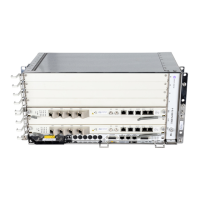Virtual Private LAN Service
198
FD 100/320Gbps NT and FX NT IHub Services Guide
3HH-11985-AAAA-TQZZA Issue: 13
5.8.3.1 Configuring STP Bridge Parameters
Modifying some of the Spanning Tree Protocol parameters allows the operator to
balance STP between resiliency and speed of convergence extremes. Modifying
particular parameters, mentioned below, must be done in the constraints of the
following two formulae:
2 x (Bridge_Forward_Delay - 1.0 seconds) >= Bridge_Max_Age
Bridge_Max_Age >= 2 x (Bridge_Hello0_Time + 1.0 seconds)
STP always uses the locally configured values for the first three parameters (Admin
State, Mode, and Priority).
For the parameters Max Age, Forward Delay, Hello Time and Hold Count, the locally
configured values are only used when this bridge has been elected root bridge in the
STP domain, otherwise the values received from the root bridge are used. The
exception to this rule is: when STP is running in RSTP mode, the Hello Time is
always taken from the locally configured parameter. The other parameters are only
used when running mode MSTP.
Bridge STP Admin State:
The administrative state of STP at the m-VPLS level is controlled by the shutdown
command.
When STP on the VPLS is administratively disabled, any BPDUs are forwarded
transparently through the ISAM. When STP on the VPLS is administratively enabled,
but the administrative state of an SAP is down, BPDUs received on such an SAP are
discarded.
configure>service>vpls <service-id> stp no shutdown
Mode
To be compatible with the different iterations of the IEEE 802.1D standard, the ISAM
supports several variants of the Spanning Tree protocol:
• rstp
Rapid Spanning Tree Protocol (RSTP) compliant with IEEE 802.1D-2004 - default
mode.
• dot1w
Compliant with IEEE 802.1w.
• comp-dot1w
Operation as in RSTP but backwards compatible with IEEE 802.1w (this mode
was introduced for interoperability with some MTU types).
• mstp
Compliant with the Multiple Spanning Tree Protocol specified in IEEE 802.1Q
REV/D5.0-09/2005.

